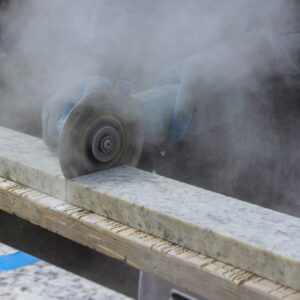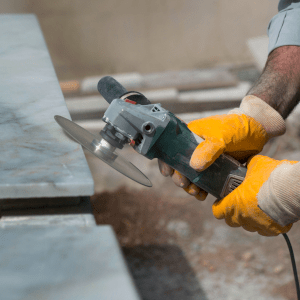 Silicosis is the name of a lung disease which is chronic and caused by the inhalation of respirable crystalline silica dust. It is an incurable, potentially fatal disease, and is often an occupational disease.
Silicosis is the name of a lung disease which is chronic and caused by the inhalation of respirable crystalline silica dust. It is an incurable, potentially fatal disease, and is often an occupational disease.
The history of silicosis is filled with ancient descriptions of lung disease, the term “silicosis” being developed, and safety regulations being introduced with the intent of reducing silicosis and other occupational lung diseases such as chronic obstructive pulmonary disease or lung cancer.
Silicosis has been around for centuries, impacting millions of workers. Today, it can lead to life-threatening injuries, which is why silicosis lawsuits have emerged.
Call us today for a free consultation if you or a loved one has been diagnosed with silicosis due to workplace exposure to silica dust. We can help you recover compensation for medical bills, lost wages, pain, suffering, wrongful death and more by filing a silicosis lawsuit. We have been representing those exposed to dangerous substances like silica dust, asbestos and paraquat since 1990, having recovered over $750,000,000 for clients. We won’t charge you any fee to handle your silicosis case until and unless we recover compensation for you. Call us today.
What Is Silicosis?
The term “silicosis” refers to a lung disease which is usually developed while working in professions involving the inhalation of dust containing silica. Silica is a tiny crystal which is found in rock, sand or ores of minerals such as quartz.
Silica may build up over time in the breathing passages and lungs, leading to scarring which can make it difficult to breathe.
There are three types of silicosis:
- Chronic simple silicosis: This is usually the result of long-term exposure to low concentrations of silica dust. This typically appears ten to 30 years after the first exposure.
- Accelerated silicosis: This is silicosis which has become “complicated” by development of serious scarring, or other lung diseases like lung cancer, autoimmune diseases, fungal infection, mycobacterial infection, or tuberculosis.
- Acute silicosis: This is silicosis which develops a few weeks to five years following exposure to large amounts of silica dust.
The hilium, the part where the nerves, blood vessels and bronchus enter the lung, commonly enlarges in chronic and accelerated silicosis.
Silicosis in Ancient Times
In ancient times,
- Silicosis has been found in Egyptian mummies’ lungs – it is thought that this was the result of exposure to silica dust during sandstorms.
- Flint miners likely suffered from silicosis during the Neolithic period.
- Silicosis was found in a European glacier mummy which is over 5,000 years old.
- Ancient Romans and Greeks recognized that dust inhalation led to respiratory problems.
- Quarry workers who had lung disease were described by Hippocrates, who described a state of breathlessness in stone quarry and mine workers exposed to dust.
- It was noted by Pliny that the disease could be prevented by respiratory protection in the form of respirators.
Silicosis Before the Industrial Revolution
Agricola wrote about lung issues from miners inhaling dust in the 16th century.
Then, just before the industrial revolution, Bernardino Ramazzini, in 1713, described sand-like substances and asthmatic symptoms in stone cutters’ lungs.
Silicosis During the Industrial Revolution
The industrial revolution saw production techniques being subjected to advancing mechanization, such as the use of power drills. This increased the risk that workers would come into contact with larger amounts of silica dust.
Industries which endangered workers during this time included mining, quarrying and manufacturing.
It was noted in 1832 that sandstone workers lived significantly shorter lives compared to brick and limestone workers, commonly dying before age 40.
This period saw a lack of safety regulations, and this likely led to many cases of the disease.
Silicosis After the Industrial Revolution
- 1897 saw the introduction of the pneumatic hammer drill
- 1904 saw the introduction of sandblasting
- A film entitled “Stop Silicosis” was released in 1938 by the United States Department of Labor
- In 1972, the United States Occupational Safety and Health Administration released a standard safety measure intended for workplaces with possible crystalline silica exposure
Discovery of Silicosis as a Disease
The symptoms of silicosis have been described in literature since ancient Egypt, and early modern era Japanese miners had a word for it: yoroke. However, “silicosis” as a term was coined in the year 1871 by Achile Visconti, an Italian physician.
It was reported by the United States Public Health Service that 60 percent of zinc and lead miners in Missouri developed diseases which were caused by the inhalation of crystalline silica.
Around 1900, Dr. Alice Hamilton documented illnesses related to silica in granite workers – her work led to significant health and safety reforms.
1917 saw the U.S. Public Health Service identify foundry workers and sandblasters as having a high risk of developing silicosis.
Later studies demonstrated a high percentage of Vermont granite quarry workers developing silicosis. Silicosis, by the late ’30s, had been described in steelworkers, foundry workers, painters, potters, sandblasters and hard-rock miners.
Silicosis in the 20th Century
 In the early 20th century, silicosis was given the nickname “the king of occupational diseases,” as it had become a public health emergency and a major occupational lung disease.
In the early 20th century, silicosis was given the nickname “the king of occupational diseases,” as it had become a public health emergency and a major occupational lung disease.
Hundreds of workers died from the disease following work on a West Virginia water tunnel in the 1930s.
The 1930s and 1940s saw laws introduced to compensate workers who developed silicosis, saw industrial hygiene programs developed, and saw guidelines established for levels of airborne silica.
In 1958, silicosis’ chest radiograph features were defined by the International Labor Organization.
1995 saw the World Health Organization and the International Labor Organization establish a global program to eliminate the disease.
In 1996, an organization known as the International Agency for Research on Cancer classified crystalline silica as being carcinogenic to humans after reviewing medical data.
Modern Understanding of Silicosis
Today, silicosis is understood as being a fibrotic, progressive lung disease which is caused when silica particles are inhaled. Recent years have seen an increase in demand for artificial stone countertops. Artificial stone releases more respirable silica dust, in the form of amorphous silica, when it is cut or shaped than other forms of stone, and this has led to a higher risk of silicosis for stone cutters.
Modern medicine has improved the diagnosis and treatment of silicosis.
While the disease can’t be cured, treatment can focus on relieving symptoms and slowing the disease’s progression.
Treatment can include:
- Using bronchodilators to decrease inflammation and relax air tubes
- Supplemental oxygen, which can help get additional air into the lungs when it is needed
- Pulmonary rehabilitation, an exercise program which helps patients maintain optimal levels of activity
- Lung transplants may be considered in severe cases
There are modern standards and regulations designed to prevent silicosis. For example, OSHA requires that employers limit workers’ exposure to respirable silica and take additional steps in order to protect workers. Employers can either utilize specific control methods or measure their workers’ exposure to silica dust and decide what dust controls work the best towards limiting exposure.
An example of an OSHA control method is using handheld power saws equipped with integrated water delivery systems which continuously feed water to blades. The water ends up limiting how much respirable silica ends up in the air.
Industries Most Affected by Silicosis
Industries which expose their workers to silica dust, increasing the risk of silicosis include stone masonry, mining and construction.
- Stone masonry: This includes stone countertop fabrication, particularly utilizing engineered stone, masonry and stone cutting.
- Construction: This includes asphalt milling, tunneling, jackhammering, drywall finishing, concrete finishing, building repair, demolition and construction, and bridge and highway construction.
- Mining: This includes mining, hydraulic fracturing and quarrying.
- Additional industries: These include concrete and cement production, pottery and ceramic production, glass manufacturing, rock drilling and abrasive blasting.
When Was Silicosis First Diagnosed?
Hippocrates, a Greek physician, first described silicosis in metal diggers in 430 B.C. However, “silicosis,” as a term, was first mentioned by Achille Visconti, an Italian physician, in 1871.
What Is the Origin of Silica Dust?
The source of silica dust is the breakdown of sand, rocks and minerals which contain crystalline silica, especially quartz. The dust gets released into the air in the form of fine particles when the materials are crushed, ground, drilled or cut during industrial activities such as manufacturing, mining and construction. The dust is a byproduct of work done using materials which contain silica.
Key points regarding silica dust:
- It has a natural source: Silica naturally occurs in the crust of the Earth and is found in soil, sand and rocks.
- Its size can be respirable: Respirable crystalline silicon dioxide is the most dangerous form of the dust. This refers to tiny particles which one can inhale deeply into their lungs.
- Numerous activities generate the dust: These activities include blasting, crushing, drilling, grinding, sawing and cutting materials such as mortar, brick, stone and concrete.
Has Anyone Survived Silicosis?
Yes, some who develop chronic silicosis may survive for numerous years after being diagnosed. Studies show that some patients may live for numerous decades after being diagnosed. The disease has no cure, though, and life expectancy is significantly reduced by the disease, which is progressive. Severe cases may see lung transplants be options to further extend life.
Key points regarding surviving silicosis:
- It has no cure: The disease does not have a cure. Treatment focuses upon management of symptoms and prevention of additional exposure to any silica dust.
- It impacts life expectancy: Life expectancy is significantly reduced by silicosis. Survival time may vary depending upon disease severity as well as individual factors.
- The disease stage matters: Survival rates are significantly impacted by the stage of disease at time of diagnosis. Earlier stages typically result in longer life expectancy.
- Lung transplants are an option: Lung transplants might get considered as last resorts to extend life in extremely advanced cases.
Legal History of Silicosis Lawsuits
The early 1930s saw awareness of the disease in the United States increase. This created an influx of lawsuits over silica exposure. Silicosis patients as well as the families of workers who died from silicosis filed lawsuits, receiving large settlements from employers and suppliers in dusty industries.
This time period saw insurers who covered companies using silica finding themselves buried under claims and lawsuits, which became a huge burden, leading to insurers lobbying for silicosis to be covered under workers’ compensation.
In the mid-1930’s, a tunnel was drilled through a West Virginia mountain by the Union Carbide Corporation. Around 2,000 workers took part in this project with little or no safety equipment used to protect the lungs. This project led to 538 lawsuits being filed against the company.
The 1970s through the 2000s saw oil refineries, oil rigs and shipyards dedicate workers to sandblasting, leading to a wave of sandblasting-related silica lawsuits.
The 21st century saw a new wave of silicosis lawsuits: lawsuits related to the stone countertop fabrication industry. In 2024, a Southern California man was awarded over $52 million in a lawsuit against artificial stone slab manufacturers which alleged that he developed silicosis due to his work with engineered slabs which are used in bathroom and kitchen countertops.
Contact a Silicosis Lawyer Today
 Call us today for a free consultation, text us from this page or fill out this page’s free case evaluation form if you or a loved one has been diagnosed with silicosis as a result of workplace exposure to silica dust.
Call us today for a free consultation, text us from this page or fill out this page’s free case evaluation form if you or a loved one has been diagnosed with silicosis as a result of workplace exposure to silica dust.
Our lawyers have been handling hazardous exposure cases just like yours for over 30 years and have recovered hundreds of millions of dollars on behalf of clients just like you. Our vast experience in holding companies accountable for subjecting workers to hazardous substances will allow us to recover the most money possible on your behalf.
No fee will be charged for us to handle your silicosis case until and unless we recover money for you. Our fee to handle your silicosis case will only be a percentage of whatever compensation we recover for you, so no upfront fee or out-of-pocket fee will be charged. You will never owe us a single penny out of your own pocket for us to handle your silicosis case.
Call us today for a free case evaluation.

